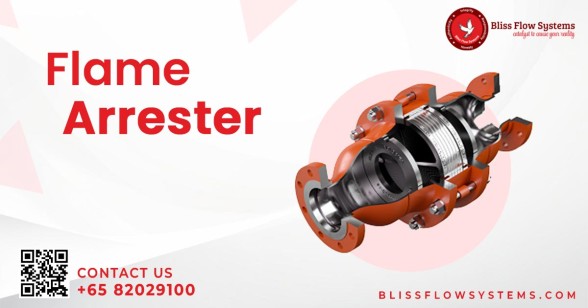


Elmac Technologies can supply different types and configurations of in-line deflagration flame arresters, suitable for a wide variety of industries.
Bliss flow systems Group, the leading supplier & distributor of Flame Arrester technology is providing you with this useful guide to deflagration and detonation pipeline explosions.
When the gas is ignited the flame begins to accelerate. This acceleration results in the build-up of a pressure wave ahead of the flame.
Given enough run-up distance, this pressure wave can build into a shock wave as the flame speed reaches sonic velocity. This first phase is known as deflagration.
Once the shock wave reaches a pressure to auto-ignite the gas through which it is traveling the flame front and shock wave couple together forming an unstable detonation.
This deflagration to detonation transition (DDT) is the most severe phase of a pipeline explosion, which can generate flame speeds of >3000m/s and high pressures, over 100bar in some cases.
In short, the deflagration Flame Arrester is designed to stop the initial phase of the explosion and is shorter and lighter than the unstable detonation arrestor, but the Deflagration Flame Arrester has restrictions on its placement within the pipe work regarding distance from the source of ignition.
If you’re unsure about Deflagration and Detonation Flame Arrester, this brief guide to explosion characteristics is designed to help. Of course, for further advice or clarification in any way, please get in touch with one of our experts.
HS(G)158 states, “Health and safety law requires that plant and equipment are maintained in a safe condition. It is essential that Flame Arresters are well maintained. They should be covered by a program of regular inspection and maintenance so they continue to be effective.”
It also goes on to say, “Keep records of the specification of each arrester, its location, and its maintenance history.” These records help to identify if the arrester is suitable for the media that it is protecting.
Should the process conditions be changed it can then be easily identified if the Flame Arrester fitted remains suitable for the new conditions.
Many issues can be identified easily through simple inspection regimes but all too often Flame Arresters are not serviced regularly.
Bliss flow systems assist with all aspects of flame arrester effectiveness, from initial inspection reports to ongoing maintenance or simply the supply of spare parts.
Standards Compliance
All Bliss flow systems Flame Arresters have been tested and certified in accordance with national or international standards. Actual device performance is verified in the Bliss flow systems state-of-the-art in-house test facility.
Whether you work in oil and gas, petrochemical, bio-fuels, or power generation, having explosion protection equipment, such as a Flame Arrester, is vital to both safety and business continuity.
You only have to look at the news. In recent years catastrophic accidents have occurred at the Stanley Refinery in Ellesmere Port, at Bunce field in Hamell Hampstead, and in Ingolstadt, southern Germany. However, the good news is that thanks to our range of patent-protected Flame Arresters and advanced flame-arresting technology and expertise,
We have simplified the process of protecting your assets against explosions and their tragic consequences.
Bliss flow systems supply and arranges the installation of the three main types of Flame Arrester: (1) End-of-Line Deflagration Flame Arresters, (2) In-Line Deflagration Flame Arresters, and (3) In-Line Detonation Flame Arresters. Our Flame Arrester are designed to meet current legislation, ATEX regulations, and all relevant ISO standards in order to ensure the safety and protection of process equipment, operators, and the environment.
Flame Arresters are often used in combination with a Pressure Relief Valve. For example, circumstances can arise where, even though a fire is contained near a storage tank, the extreme heat given off can cause the pressure inside these vessels to increase beyond their design limits. The resulting failure, due to the lack of correct equipment installation, has often given rise to disastrous consequences.
A Flame Arrester, and correctly sized and installed Emergency Relief Vent, serve to provide maximum protection in the most arduous circumstances.
As is true for all safety equipment, Flame Arresters can cease to function if they’re not correctly specified or installed in the first place, or poorly or inadequately maintained thereafter.
Accordingly, we recommend that Flame Arresters and other safety devices should be inspected at least annually and more frequently where operating conditions dictate increased maintenance.
